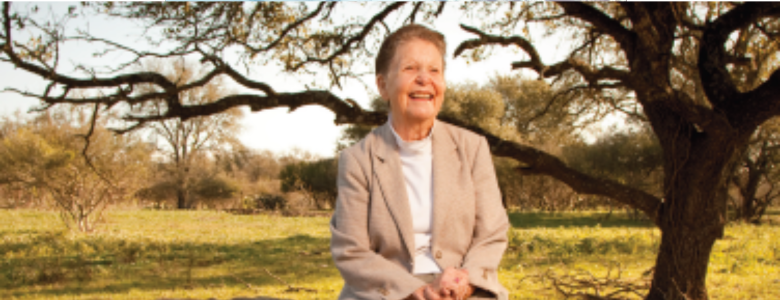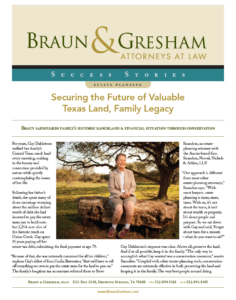Braun Safeguards Family’s Historic Ranchland & Financial Situation Through Conservation
For years, Gay Dahlstrom walked her family’s Central Texas ranch land every morning, soaking in the beauty and connection provided by nature while quietly contemplating the issues of her life.
Following her father’s death, she spent many of those mornings worrying about the million dollars’ worth of debt she had incurred to pay the estate taxes just to hold onto her 2,254-acre slice of the historic ranch on Onion Creek. Gay spent 15 years paying off her estate-tax debt, submitting the final payment at age 79.
“Because of that, she was extremely concerned for all her children,” explains Gay’s eldest of four, Cecilia Barrentine, “that we’d have to sell off everything we own to pay the estate taxes for the land to pass on.” The family’s longtime tax accountant referred them to Steve Saunders, an estate planning attorney with the Austin-based firm Saunders, Norval, Nichols & Atkins, LLP.
“Our approach is different from most other estate-planning attorneys,” Saunders says. “With most lawyers, estate planning is taxes, taxes, taxes. With us, it’s not about the taxes, it isn’t about wealth or property. It’s about people and purpose. So we sat down with Gay and said, ‘Forget about taxes for a minute – what do you want to do?’”
Gay Dahlstrom’s response was clear: Above all, preserve the land. And if at all possible, keep it in the family. “The only way to accomplish what Gay wanted was a conservation easement,” asserts Saunders. “Coupled with other estate-planning tools, conservation easements are extremely effective in both preserving the land and keeping it in the family. The very best people around doing conservation easements are (experienced Central Texas land-conservation attorneys) Braun & Gresham. They have the creativity, the experience, the resourcefulness and the dogged determination to get it done.”
“The very best people around doing conservation easements area … Braun & Gresham. They have the creativity, the experience, the resourcefulness and the dogged determination to get it done.” – Steve Saunders, Saunders, Norval, Nichols, & Atkins, LLP.
The Braun team began working with Gay’s son, Jack Dahlstrom, Jr., guiding the family toward a conservation easement – an agreement that would keep Dahlstrom Ranch intact, restrict development, protect the ranch’s natural features and habitats, and let the family continue to own, live on and use the land, all in perpetuity. Additionally, an easement would provide the family with federal income tax savings in the short term, and more manageable estate taxes in the long run.
“Of all estate-planning tools,” Braun attorney Thomas Hall begins, “a conservation easement has the single biggest impact on property value for the purpose of managing your federal estate tax. With the Dahlstroms, what we had was a family whose wealth was tied up in the land they loved. The conservation easement let them monetize a land value – the property’s development potential – which they never intended to use.”
Under a conservation easement, the landowner retains legal title to the property, but donates or sells the development rights to a land trust (in this case, the Hill Country Conservancy), and the trust ensures the land is preserved forever according the landowner’s wishes. Once the landowner and land trust complete the agreement, the conservation easement terms can be changed only through mutual consent. Early on, the Braun team discovered that the Dahlstrom ranchland had great environmental, geological and historical significance to its Central Texas community. So, in order to protect such important property, the team pursued public monies to help pay the family for part of the value of the conservation easement.
Coordinating and negotiating the transaction proved to be an epic task, involving five parties with differing priorities and a three-year process start to finish. The Braun team ultimately facilitated a unique partnership between the Dahlstrom family, Hays County, the City of Austin, and the Natural Resources Conservation Service via the Hill Country Conservancy to purchase some of the value of the Dahlstrom Ranch conservation easement.
The value of the conservation easement was appraised at $20.7 million. The public monies from the partners totaled $9.9 million; the family donated the other $10.8 million to complete the agreement. As a result of their charitable donation, the Dahlstroms benefit from a federal income tax deduction for six years, as well as a much more manageable estate-tax liability due to the severely reduced fair-market value of the property.
“When Gay sold and donated her developmental rights as part of the easement, she literally reduced her property’s value by more than 78 percent,” notes Saunders. “But most importantly, with this agreement, all of Gay’s desires for the land were fulfilled: Not only has she preserved the land, but she also achieved a whole different situation for keeping it in the family. Before, it was virtually impossible; now, not only is it possible, but it happened – benefiting the family and Central Texas overall.”



